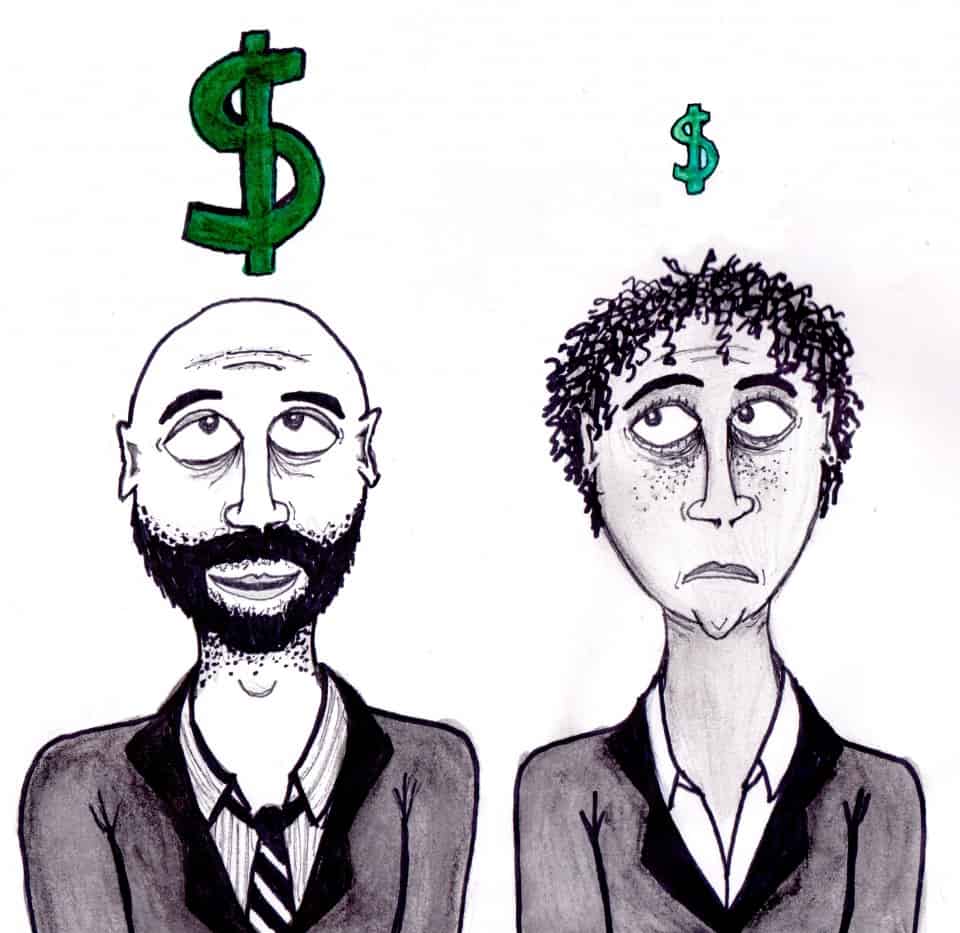[dropcap]Jennifer[/dropcap] Lawrence recently wrote an essay sharing her experience of gender income inequality in Hollywood. After the Sony hack, realizing she was being paid considerably less than her male co-stars, she expressed frustration at refraining from negotiating for better pay, lest she be perceived as “spoiled” or “difficult.”
This problem is not exclusive to the US. Canadian women make 73 cents for every dollar men earn in full-year, full-time positions. Statistics Canada has also found that female average annual income is $32,100, with males making an average of $48,100, The Toronto Star has reported women earn 31.5 per cent less than men in Ontario.
Many have argued that this gap is natural, given that women tend to enter lower paying jobs than men. Margaret Wente at The Globe and Mail, for instance, suggests: “Instead of sociology, [women] should take petroleum engineering, which pays three or four times as much. That would close the gap in no time.”
This line of reasoning is erroneous. Even if we disaggregate the statistics to situations in which men and women are in the same occupation, they are still paid unequal wages. In fact, a 2012 study by the American Association of University Women (AAUW) looked at men and women only a year out of college and already found a 7 per cent gap in wages, even when “school selectivity, grades, choice of major, choice of occupation, and hours-worked were taken into account.”
Perhaps the wage gap is due, then, to
women’s apparent lack of ambition or
willingness to negotiate for higher salaries. Again, this is a lazy argument: Catalyst’s 2011 longitudinal study of leading business schools in the US, Canada, Europe, and Asia reports that “when women did all the things they have been told will help them get ahead — using the same tactics as men — they still advanced less than their male counterparts and had slower pay growth.”
As The Globe and Mail reported in 2012, the pay gap may simply be a function of discriminatory assignment of raises — when 184 managers were put in a scenario to negotiate salaries with employees who had identical skills and responsibilities, they awarded men raises nearly 2.5 times larger than they did for women.
To humour the naysayers, however, let’s assume that the wage gap is entirely due to differences in women’s occupation, hours worked, or failure to negotiate. It must be underlined that such “choices” are often products of gender stereotypes, and are not entirely the “fault” of women themselves. For instance, many employers assume women will want to start a family instead of focusing on their job, fearing they will lose employees who will go on maternity leave. Manager surveys have shown that employers will discriminate against young women, preferring older women, or better yet, men. This pushes women towards part-time work and lower-wage careers.
The same gender stereotypes of women as being naturally caring and affectionate means they continue to bear the burden of household responsibilities. Indeed, Statistics Canada has reported that women spend more than double the average number of hours that men do taking care of children. This is also equal to more than one and a half times the average number of hours that men spent on domestic work. Clearly, this would take women’s time away from the hours they’re able to spend in the office.
As for negotiation, Lawrence’s essay
highlights the way women are penalized for attempting to negotiate — women who speak up and ask for more are seen as antagonistic or overly demanding. Indeed, Hannah Riley Bowles from Harvard’s Kennedy School of Government has conducted several experimental studies that confirm the social cost of bargaining salaries is higher for women than it is for men. Knowing this, it seems unfair to blame women for failing to negotiate.
However, there are avenues for change. Ryerson University compiles and releases all faculty university-wide average salaries by
department, allowing faculty to compare their pay to others and appeal for a raise if they are unsatisfied. Furthermore, at McMaster University, the base salary of female faculty was raised by $3,515 last July to combat bias in favour of male faculty. If employers around the world could adopt gender pay equality practices similar to these universities, we could work towards global income equality.
Do not blame female employees for the income wage gap, because it isn’t for lack of trying. Women are not less qualified, working less, or making lower-wage career choices. Female labour is as vital to companies as the labour provided by male employees, and women deserve to be valued for their efforts.
Naomi Stuleanu is a second-year student at Victoria College studying criminology and psychology.


